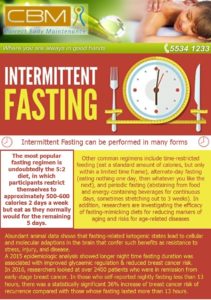Intermittent Fasting
Intermittent Fasting can be performed in many forms.
The most popular fasting regimen is undoubtedly the 5:2 diet, in which participants restrict themselves to approximately 500-600 calories 2 days a week but eat as they normally would for the remaining 5 days.
Other common regimens include time-restricted feeding (eat a standard amount of calories, but only within a limited time frame), alternate-day fasting (eating nothing one day, then whatever you like the next), and periodic fasting (abstaining from food and energy-containing beverages for continuous days, sometimes stretching out to 3 weeks). In addition, researchers are investigating the efficacy of fasting-mimicking diets for reducing markers of aging and risks for age-related diseases
Abundant animal data shows that fasting-related ketogenic states lead to cellular and molecular adaptions in the brain that confer such benefits as resistance to stress, injury, and disease.
A 2015 epidemiologic analysis showed longer night time fasting duration was associated with improved glycaemic regulation & reduced breast cancer risk.
In 2016, researchers looked at over 2400 patients who were in remission from early-stage breast cancer. In those who self-reported nightly fasting less than 13 hours, there was a statistically significant 36% increase of breast cancer risk of recurrence compared with those whose fasting lasted more than 13 hours.



